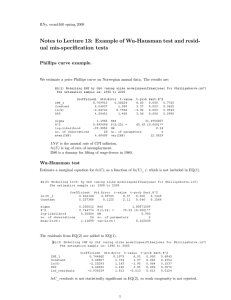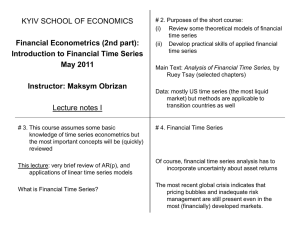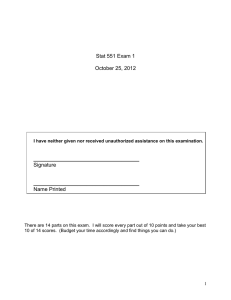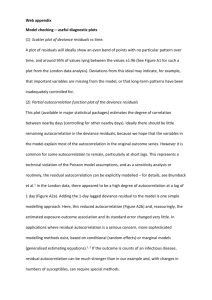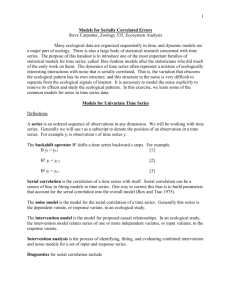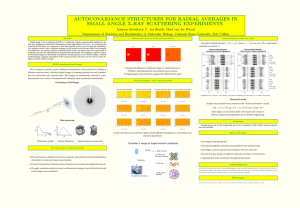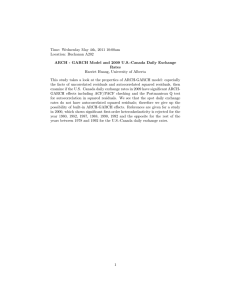How should these data be modelled? 14 12 10
advertisement
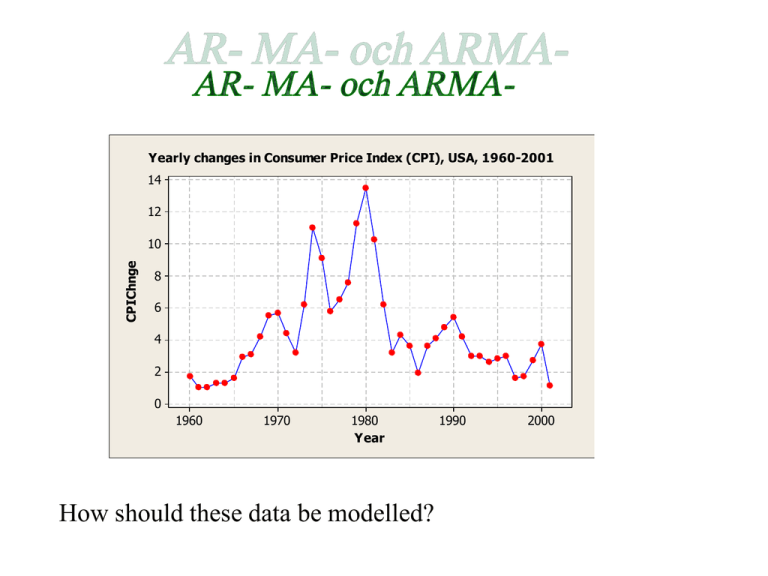
Yearly changes in Consumer Price Index (CPI), USA, 1960-2001
14
12
CPIChnge
10
8
6
4
2
0
1960
1970
1980
Year
How should these data be modelled?
1990
2000
Identification step: Look at the SAC and SPAC
Autocorrelation Function for CPIChnge
(with 5% significance limits for the autocorrelations)
1.0
0.8
Autocorrelation
0.6
0.4
0.2
0.0
-0.2
-0.4
-0.6
-0.8
-1.0
1
2
3
4
5
6
Lag
7
8
9
10
11
10
11
Partial Autocorrelation Function for CPIChnge
(with 5% significance limits for the partial autocorrelations)
1.0
Looks like an AR(1)process. (Spikes are clearly
decreasing in SAC and
there is maybe only one
sign. spike in SPAC)
Partial Autocorrelation
0.8
0.6
0.4
0.2
0.0
-0.2
-0.4
-0.6
-0.8
-1.0
1
2
3
4
5
6
Lag
7
8
9
Then we should try to fit the model
yt yt 1 at
The parameters to be estimated are and .
One possibility might be to uses Least-Squares estimation
(like for ordinary regression analysis)
Not so wise, as both response and explanatory variable are
randomly varying.
Maximum Likelihood better So-called Conditional
Least-Squares method can be derived
Use MINITAB’s ARIMA-procedure!!
AR(1)
We can always ask for forecasts
MTB > ARIMA 1 0 0 'CPIChnge';
SUBC>
Constant;
SUBC>
Forecast 2 ;
SUBC>
GSeries;
SUBC>
GACF;
SUBC>
GPACF;
SUBC>
Brief 2.
ARIMA Model: CPIChnge
Estimates at each iteration
Iteration
SSE
Parameters
0
316.054
0.100
4.048
1
245.915
0.250
3.358
2
191.627
0.400
2.669
3
153.195
0.550
1.980
4
130.623
0.700
1.292
5
123.976
0.820
0.739
6
123.786
0.833
0.645
7
123.779
0.836
0.626
8
123.778
0.837
0.622
9
123.778
0.837
0.621
Relative change in each estimate less than 0.0010
Final Estimates of Parameters
Type
AR
SE Coef
T
P
0.8369
0.0916
9.13
0.000
0.6211
0.2761
2.25
0.030
3.809
1.693
1
Coef
Constant
Mean
Number of observations:
Residuals:
ˆ
ˆ
42
SS =
122.845 (backforecasts excluded)
MS =
3.071
DF = 40
Time Series Plot for CPIChnge
(with forecasts and their 95% confidence limits)
15
All spikes should be
within red limits here,
i.e. no correlation
should be left in the
residuals!
5
0
1
5
10
15
20
25
30
35
40
Time
ACF of Residuals for CPIChnge
PACF of Residuals for CPIChnge
(with 5% significance limits for the autocorrelations)
(with 5% significance limits for the partial autocorrelations)
1.0
1.0
0.8
0.8
0.6
0.6
Partial Autocorrelation
Autocorrelation
CPIChnge
10
0.4
0.2
0.0
-0.2
-0.4
-0.6
0.4
0.2
0.0
-0.2
-0.4
-0.6
-0.8
-0.8
-1.0
-1.0
1
2
3
4
5
6
Lag
7
8
9
10
1
2
3
4
5
6
Lag
7
8
9
10
Modified Box-Pierce (Ljung-Box) Chi-Square statistic
Lag
Chi-Square
DF
P-Value
12
24
36
48
26.0
35.3
39.8
*
10
22
34
*
0.004
0.036
0.227
*
Forecasts from period 42
95% Limits
Period
Forecast
Lower
Upper
43
1.54176
-1.89376
4.97727
44
1.91148
-2.56850
6.39146
Actual
Ljung-Box statistic:
K
Q* K n d n d 2 n d l rl 2 (aˆ )
l 1
where
n is the sample size
d is the degree of non-seasonal differencing used to
transform original series to be stationary. Non-seasonal
means taking differences at lags nearby.
rl2(â) is the sample autocorrelation at lag l for the residuals
of the estimated model.
K is a number of lags covering multiples of seasonal cycles,
e.g. 12, 24, 36,… for monthly data
Under the assumption of no correlation left in the residuals the
Ljung-Box statistic is chi-square distributed with K – nC degrees of
freedom, where nC is the number of estimated parameters in model
except for the constant
A low P-value for any K should be taken as evidence for
correlated residuals, and thus the estimated model must be revised.
In this example:
Here, data is not supposed
to possess seasonal
variation so interest is
mostly paid to K = 12.
Modified Box-Pierce (Ljung-Box)
Chi-Square statistic
K
Lag
Chi-Square
DF
P-Value
12
24
36
48
26.0
35.3
39.8
*
10
22
34
*
0.004
0.036
0.227
*
P – value for K =12 is
lower than 0.05
Model needs revision!
A new look at the SAC and SPAC of original data:
Autocorrelation Function for CPIChnge
(with 5% significance limits for the autocorrelations)
1.0
0.8
The second spike in SPAC might be
considered crucial!
Autocorrelation
0.6
0.4
0.2
0.0
-0.2
-0.4
-0.6
-0.8
-1.0
1
2
3
4
5
6
Lag
7
8
9
10
11
If an AR(p)-model is correct, the ACF
should decrease exponentially
(monotonically or oscillating)
and PACF should have exactly p
significant spikes
Partial Autocorrelation Function for CPIChnge
(with 5% significance limits for the partial autocorrelations)
1.0
Partial Autocorrelation
0.8
0.6
0.4
Try an AR(2)
0.2
0.0
-0.2
i.e.
-0.4
-0.6
-0.8
-1.0
1
2
3
4
5
6
Lag
7
8
9
10
11
yt 1 yt 1 2 yt 1 at
Type
Coef
SE Coef
T
P
AR
1
1.1684
0.1509
7.74
0.000
AR
2
-0.4120
0.1508
-2.73
0.009
1.0079
0.2531
3.98
0.000
4.137
1.039
Constant
Mean
Number of observations:
Residuals:
42
SS =
103.852 (backforecasts excluded)
MS =
2.663
DF = 39
PREVIOUS MODEL:
Residuals:
SS = 122.845
(backforecasts excluded)
MS =
3.071
Modified Box-Pierce (Ljung-Box) Chi-Square statistic
Lag
DF = 40
Chi-Square
Modified Box-Pierce (Ljung-Box) ChiSquare statistic
Lag
Chi-Square
DF
P-Value
12
24
36
48
26.0
35.3
39.8
*
10
22
34
*
0.004
0.036
0.227
*
Forecasts from period 42
95% Limits
Period
Actual
Forecast
Lower
Upper
43
1.54176
-1.89376
4.97727
44
1.91148
-2.56850
6.39146
12
24
36
48
18.6
30.6
36.8
*
9
21
33
*
0.029
0.081
0.297
*
DF
P-Value
Forecasts from period 42
95% Limits
Period
Forecast
Lower
Upper
43
0.76866
-2.43037
3.96769
44
1.45276
-3.46705
6.37257
Actual
ACF of Residuals for CPIChnge
(with 5% significance limits for the autocorrelations)
1.0
0.8
Autocorrelation
0.6
0.4
0.2
0.0
-0.2
-0.4
-0.6
-0.8
-1.0
1
2
3
4
5
6
7
8
9
10
Lag
Might still be problematic!
PACF of Residuals for CPIChnge
(with 5% significance limits for the partial autocorrelations)
1.0
Partial Autocorrelation
0.8
0.6
0.4
0.2
0.0
-0.2
-0.4
-0.6
-0.8
-1.0
1
2
3
4
5
6
Lag
7
8
9
10
Could it be the case of an Moving Average (MA) model?
MA(1):
yt at at 1
{at } are still assumed to be uncorrelated and identically
distributed with mean zero and constant variance
MA(q):
yt at 1 at 1 q at q
• always stationary
• mean =
• is in effect a moving average with weights
1,1 , 2, , q
for the (unobserved) values at, at – 1, … , at – q
Time Series Plot of AR(1)_0.2
Time Series Plot of MA(1)_0.2
5
3
2
3
MA(1)_0.2
AR(1)_0.2
4
2
1
0
-1
1
-2
0
1
20
40
60
80
100
Index
120
140
160
180
-3
200
1
30
60
Time Series Plot of AR(1)_0.8
120
150
Index
180
210
240
270
300
240
270
300
Time Series Plot of MA(1)_0.8
4
14
13
3
12
2
11
1
MA(1)_0.8
AR(1)_0.8
90
10
9
8
0
-1
-2
7
-3
6
5
-4
1
20
40
60
80
100
Index
120
140
160
180
200
1
30
60
90
120
150
Index
180
210
Time Series Plot of AR(1)_(-0.5)
Time Series Plot of MA(1)_(-0.5)
5
4
4
3
2
2
MA(1)_(-0.5)
AR(1)_(-0.5)
3
1
0
1
0
-1
-1
-2
-2
-3
-3
1
20
40
60
80
100
Index
120
140
160
180
200
1
30
60
90
120
150
Index
180
210
240
270
300
Try an MA(1):
Final Estimates of Parameters
Type
Coef
SE Coef
T
P
-1.0459
0.0205
-51.08
0.000
Constant
4.5995
0.3438
13.38
0.000
Mean
4.5995
0.3438
MA
1
Number of observations:
Residuals:
42
SS =
115.337 (backforecasts excluded)
MS =
2.883
DF = 40
Modified Box-Pierce (Ljung-Box) Chi-Square statistic
Lag
Chi-Square
DF
P-Value
12
24
36
48
38.3
92.0
102.2
*
10
22
34
*
0.000
0.000
0.000
*
Not at all good!
Forecasts from period 42
95% Limits
Period
Forecast
Lower
Upper
43
1.27305
-2.05583
4.60194
44
4.59948
-0.21761
9.41656
Actual
Much wider!
Time Series Plot for CPIChnge
(with forecasts and their 95% confidence limits)
15
5
0
1
5
10
15
20
25
30
35
40
Time
ACF of Residuals for CPIChnge
PACF of Residuals for CPIChnge
(with 5% significance limits for the autocorrelations)
(with 5% significance limits for the partial autocorrelations)
1.0
1.0
0.8
0.8
0.6
0.6
Partial Autocorrelation
Autocorrelation
CPIChnge
10
0.4
0.2
0.0
-0.2
-0.4
-0.6
0.4
0.2
0.0
-0.2
-0.4
-0.6
-0.8
-0.8
-1.0
-1.0
1
2
3
4
5
6
Lag
7
8
9
10
1
2
3
4
5
6
Lag
7
8
9
10
Still seems to be problems with residuals
Look again at ACF and PACF of original series:
Autocorrelation Function for CPIChnge
(with 5% significance limits for the autocorrelations)
The pattern corresponds
neither with pure AR(p), nor
with pure MA(q)
1.0
0.8
Autocorrelation
0.6
0.4
0.2
0.0
-0.2
-0.4
-0.6
-0.8
-1.0
1
2
3
4
5
6
Lag
7
8
9
10
11
Partial Autocorrelation Function for CPIChnge
(with 5% significance limits for the partial autocorrelations)
Could it be a combination of
these two?
1.0
Partial Autocorrelation
0.8
0.6
0.4
Auto Regressive Moving
Average (ARMA) model
0.2
0.0
-0.2
-0.4
-0.6
-0.8
-1.0
1
2
3
4
5
6
Lag
7
8
9
10
11
ARMA(p,q):
yt 1 yt 1 p yt p at 1 at 1 q at q
• stationarity conditions harder to define
• mean value calculations more difficult
• identification patterns exist, but might be complex:
– exponentially decreasing patterns or
– sinusoidal decreasing patterns
in both ACF and PACF (no cutting of at a certain lag)
Time Series Plot of ARMA(1,1)_(-0.2)(-0.2)
3
2
2
ARMA(1,1)_(-0.2)(-0.2)
3
1
0
-1
-2
1
0
-1
-2
-3
-3
1
30
60
90
120
150
Index
180
210
240
270
300
1
30
60
90
120
Time Series Plot of ARMA(2,1)_(0.1)(0.1)_(-0.1)
3
ARMA(2,1)_(0.1)(0.1)_(-0.1)
ARMA(1,1)_(0.2)(0.2)
Time Series Plot of ARMA(1,1)_(0.2)(0.2)
2
1
0
-1
-2
-3
-4
1
30
60
90
120
150
Index
180
210
240
270
300
150
Index
180
210
240
270
300
Always try to keep p and q small.
Try an ARMA(1,1):
Type
Coef
SE Coef
T
P
AR
1
0.6558
0.1330
4.93
0.000
MA
1
-0.9324
0.0878
-10.62
0.000
1.3778
0.4232
3.26
0.002
4.003
1.230
Constant
Mean
Number of observations:
Residuals:
42
SS =
77.6457 (backforecasts excluded)
MS =
1.9909
DF = 39
Modified Box-Pierce (Ljung-Box) Chi-Square statistic
Lag
Chi-Square
12
24
36
48
8.4
21.5
28.3
*
9
21
33
*
0.492
0.429
0.699
*
DF
P-Value
Much better!
Forecasts from period 42
95% Limits
Period
Forecast
Lower
Upper
43
-1.01290
-3.77902
1.75321
44
0.71356
-4.47782
5.90494
Actual
Time Series Plot for CPIChnge
(with forecasts and their 95% confidence limits)
15
5
0
Now OK!
-5
1
5
10
15
20
25
30
35
40
Time
ACF of Residuals for CPIChnge
PACF of Residuals for CPIChnge
(with 5% significance limits for the autocorrelations)
(with 5% significance limits for the partial autocorrelations)
1.0
1.0
0.8
0.8
0.6
0.6
Partial Autocorrelation
Autocorrelation
CPIChnge
10
0.4
0.2
0.0
-0.2
-0.4
-0.6
0.4
0.2
0.0
-0.2
-0.4
-0.6
-0.8
-0.8
-1.0
-1.0
1
2
3
4
5
6
Lag
7
8
9
10
1
2
3
4
5
6
Lag
7
8
9
10
Calculating forecasts
For AR(p) models quite simple:
yˆ t 1 ˆ ˆ1 yt ˆ2 yt 1 ˆp yt ( p 1)
yˆ t 2 ˆ ˆ1 yˆ t 1 ˆ2 yt ˆp yt ( p 2 )
yˆ t p ˆ ˆ1 yˆ t ( p 1) ˆ2 yˆ t ( p 2 ) ˆp yt
yˆ t p 1 ˆ ˆ1 yˆ t p ˆ2 yˆ t ( p 1) ˆp yˆ t 1
at + k is set to 0 for all values of k
For MA(q) ??
MA(1):
yˆt ˆ at ˆ at 1
If we e.g. would set at and at – 1 equal to 0
the forecast would constantly be ˆ
which is not desirable.
Note that
yt 1 at 1 at 2
yt at at 1
at 2 0
at yt yt 1 (1 )
aˆt yt ˆ yt 1 (1 ˆ) ˆ
Similar investigations for ARMA-models.
